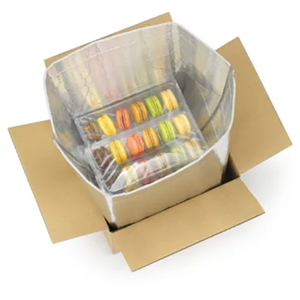Companies and consumers are becoming increasingly interested in sustainability and environmental friendliness. In the discussion about the more conscious use of plastic, one quickly ends up with plastic bags. Wherever possible, their use should be avoided. And if it’s not possible? Reuse, recycle.
Are plastic bags completely recyclable? Can plastic bags with paper labels be recycled? Which plastic bags are generally recyclable?
Consumption of plastic bags in private households and industry
From plastic carrier bags – of which the average German household consumed 24 last year (Plastic bag consumption in private households), to zipper bags, self-sealing bags, shopping bags, rubbish bags and special covers for pallets and other industrial goods – the plastic bag is so useful that it is not 100% replaceable.
But the issues of recycling and reuse are becoming an important consumer consideration – so what can we do to ensure that plastic bags are properly recycled and also reused?
We look at how plastic bags are made, what they are made of, how they can be reused and, if not reused, how they can actually be recycled into raw materials.
How is plastic made?
Before we look at recycling and reusing plastic bags, we first need to know how plastic bags are made. What plastic bags are made of depends on how they are used, but most of the bags used in packaging are made of different grades of polyethylene.
Plastic bags are made from oil. In fact, six per cent of all oil is used to make plastics, and plastic bags account for about 40 per cent of the use of these plastics. Oil is processed using heat and pressure to form long-chain molecules of polyethylene, which arrive as plastic pellets.
Different combinations of heat and pressure produce different densities of plastic, with carrier bags typically made from high-density polyethylene (HDPE) and plastic films and thinner bags from low-density polyethylene (LDPE).
Polyethylene pellets as a basis
Polyethylene pellets are the starting point for plastic bags. These pellets are heated and extruded into films – of varying thickness depending on their use – which are then cut to size and the seams in turn sealed with heat to form a bag. The films, made from polyethylene, are considered particularly durable: The material can handle great cold (it only becomes brittle at temperatures around -50°C and is therefore considered very cold-resistant) as well as great heat: the limit for PE-LD* is between 70 and 80 °C, for PE-HD* even over 100 °C, which becomes relevant when welding the films.
How can plastic be recycled?
Plastic bags are very resilient, relative to their weight, and tend not to weather or degrade quickly (this can take up to 20 years), making them ideal for repeated use. What are the options for reuse?
Reuse of plastic bags
- Primary: The obvious way is to reuse them as bags. Plastic carrier bags can be used repeatedly to transport food or other products after their first use. These and other types of plastic bags can also be used to store a wide variety of items or to keep them clean, fresh and protected.
- Secondary: Apart from reusing plastic bags as bags, they have all sorts of other secondary uses. For example, they are ideal for covering outdoor plants in winter to protect them from frost. They can also be used as padding in parcels you send by post.Used bags can also be used to protect paint brushes when not in use, to line paint trays, cat litter trays and even bird cages – and last but not least, for creative crafting with plastic bags 🙂
- Final: When they have reached the end of their (re-)useable life, they can be used as small Bin liners and thus fulfil their (final) purpose. At this point, the question of how to recycle plastic becomes increasingly important.
Labelling of plastic types
Labels or imprints with these markings can also be found on bags – and other plastic items. They describe in more detail what they are made of and how they should be disposed of/recycled. These describe the material(s) used to make the bag and what they can be used for. The following is an excerpt from the table of Recycling codes (wikipedia):| Material and number | full name | Use, recycled used as |
|---|---|---|
| PET – 01 | Polyethylene terephthalate | Polyester fibres, films, bottles for food and other liquids, food packaging |
| PE-HD -02 | High-densitypolyethylene | Plastic bottles, waste bins, plastic pipes, artificial wood |
| PVC – 03 | Polyvinyl chloride | Window frames and pipes |
| PE-LD -04 | Polyethylene Low-Density | Plastic bags, buckets, soap dispenser bottles, plastic tubes, foils |
| PP -05 | Polypropylene | Bumpers, interior trim, industrial fibres, food packaging, DVD and Blu-ray cases |
| PS -06 | Polystyrene | Toys, flower pots, video cassettes, CD cases, ashtrays, suitcases, foam polystyrene, food packaging |
| O (Other) | Other plastics such as polycarbonate (PC), polyamide (PA), acrylonitrile butadiene styrene (ABS), polymethyl methacrylate (PMMA), polylactide (PLA), etc. | No. 7 is defined neither in the German Packaging Ordinance nor in the European Packaging Directive. The principle is: Labelling is voluntary, but if I label, I label according to specifications. This means that No. 7 cannot be used at whim. The basic problem here is the outdated legal basis – for example, LLDPE and other materials used in plastics processing such as EVOH or adhesion promoters are also missing from this list. |
Source: https://de.wikipedia.org/wiki/Recycling-Code
Are plastic shipping bags recyclable?
So can you recycle plastic shipping bags? As many types of bags are used to ship goods – in the e-commerce age there is a growing demand for plastic bags – the question of the recyclability of the bags on offer increasingly comes up. The answer is simple: as long as they are made of LDPE or HDPE and, if they are labelled, these have paper packaging labels, the Shipping bags recyclable.
Some shipping bags contain padding – such as. Bubble bags – to protect more delicate items in the mail or during transport, which can also be recycled as long as the padding and the bag are made of polyethylene.
For other goods, especially sensitive electronics, some mailing bags have an integrated metallised shield. These bags suitable for electronics are made of LDPE, but also have a layer of metallised polyester to protect the inside from static charge.
The rise of e-commerce and the sale of more electronic devices is increasing the need for this type of composite packaging, both for the delivery of electronic components to manufacturers and for the delivery of finished products to consumers.
In theory, these can be recycled as both materials – polyethylene and metallised polyester – can be recycled. In practice, however, the two layers are almost impossible to separate and unfortunately contaminate each other during recycling.
Plastic bags and pouches- our conclusion
Plastic bags may be in the news as a potential environmental hazard, but they are endlessly reusable for all sorts of secondary purposes around the home and business – from storing parts to being used again as packaging and padding for shipping by post. As the use of plastic bags for shipping goods increases – driven by e-commerce – their use inevitably increases, but as long as you stick to using polythene bags, not only can they be reused, they can be recycled and turned into new ones, environmentally friendly bags and much more.















